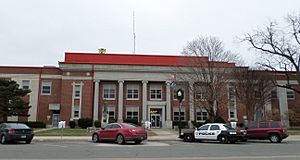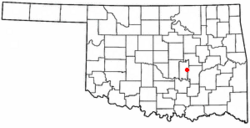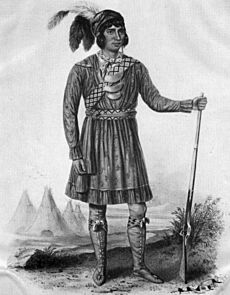Wewoka, Oklahoma facts for kids
Quick facts for kids
Wewoka, Oklahoma
|
|
|---|---|

Seminole County Courthouse
|
|

Location of Wewoka, Oklahoma
|
|
| Country | United States |
| State | Oklahoma |
| County | Seminole |
| Government | |
| • Type | Council-manager |
| Area | |
| • Total | 4.84 sq mi (12.54 km2) |
| • Land | 4.84 sq mi (12.54 km2) |
| • Water | 0.00 sq mi (0.00 km2) |
| Elevation | 873 ft (266 m) |
| Population
(2020)
|
|
| • Total | 3,133 |
| • Density | 647.31/sq mi (249.91/km2) |
| Time zone | UTC-6 (Central (CST)) |
| • Summer (DST) | UTC-5 (CDT) |
| ZIP code |
74884
|
| Area code(s) | 405 and 572 |
| FIPS code | 40-80550 |
| GNIS feature ID | 2412246 |
Wewoka is a city in Seminole County, Oklahoma, United States. In 2020, about 3,133 people lived there. It is the main city, or county seat, of Seminole County.
Wewoka was started in January 1849 by a group of Black Seminole people, led by John Coheia. It is the capital city of the Seminole Nation of Oklahoma.
Contents
History of Wewoka
Wewoka's story began with a Black Seminole leader named John Horse, also known as Gopher John. In 1849, he and other Black Seminoles created a settlement near where Wewoka is today. They wanted a safe place away from the Creek Nation.
They built their community by a small stream with waterfalls. The sound of the water gave the place its name, We-Wo-Ka. This means "Barking Water" in the Mvskoke (Seminole) language. Some historians think it was named Wewokea after Osceola's second wife. She was part Seminole and part African.
Later in 1849, John Horse and Seminole chief Wild Cat led families to Mexico. They wanted to avoid slave traders who were trying to capture people of African descent. The Mexican government offered them land if they could help stop outlaws.
Wewoka's Founding and Growth
The city of Wewoka was officially founded in 1866. Elijah J. Brown, a government worker, led Seminole people back from Leroy, Kansas. During the American Civil War, many Seminole people had fled to Kansas for safety.
After the war, the U.S. government made the Seminole Nation sign a new treaty. This treaty said they had to free their slaves. It also gave these freed people full rights as tribal citizens, including voting.
Elijah Brown led the Seminole people back to Wewoka. He built a house and a trading post there. Freed people and Seminoles settled in Wewoka. The trading post later became the Wewoka Trading Company in 1891.
A missionary named Rev. James Ross Ramsey started the Ramsey Mission in 1866. This was the first school in what is now Seminole County. A post office opened in Wewoka in 1867. The Seminole Nation made Wewoka their capital city. In 1877, Seminole Governor John Brown built a log house as the Seminole capitol.
The federal government used to send payments directly to Seminole tribe members. These payments were brought by a special "pay wagon." It was guarded by armed Seminole light horsemen. The money was stored in the Wewoka Trading Company's vault. A. J. Brown, who was also the Treasurer of the Seminole Nation, would then give the money to the right people.
The Choctaw, Oklahoma and Gulf Railroad built a train line through Wewoka. The city was formally planned out in 1897. At first, only American Indians could buy land lots. But in 1902, this rule changed, and white settlers could buy land too.
In 1907, Oklahoma became a state, and Wewoka became part of it. In 1908, Wewoka was chosen as the county seat of Seminole County, Oklahoma. It won against the city of Seminole, Oklahoma in an election.
Oil Boom and Changes
On March 16, 1923, oil was found near Wewoka. This was part of the Greater Seminole Oil Field. Many Seminole people became very wealthy in 1925 when the Magnolia Petroleum Company started drilling. In the 1920s and 1930s, the Seminole Oil Fields were some of the biggest oil suppliers in the world.
In 1925, Wewoka had about 1,520 people. By 1927, the population grew to over 20,000! Many people came to Wewoka hoping to make their fortune. It quickly became the third-largest city in Oklahoma.
After the 1920s, oil production started to decrease. As oil jobs left, people also left the city. By 1950, Wewoka's population was 6,753. It continued to decline, but the city remained an important business center for the area. The 1980s and 1990s were tough for Wewoka. Many businesses closed, and poverty increased.
City leaders worked to improve things in the mid-1990s. The police force grew, and crime rates went down. By 2001, the crime rate was lower than the average for Oklahoma. The historic downtown area was also improved with new sidewalks, streets, and lights. In 2004, Wewoka was even named one of Channel 5's Top Five Cities.
Wewoka continues to try and attract new businesses and keep its population. The city is still diverse, with people from many backgrounds living there.
Geography
Wewoka covers about 4.8 square miles (12.5 km2) of land. There is no water area within the city limits.
Demographics
| Historical population | |||
|---|---|---|---|
| Census | Pop. | %± | |
| 1910 | 1,022 | — | |
| 1920 | 1,520 | 48.7% | |
| 1930 | 10,401 | 584.3% | |
| 1940 | 10,315 | −0.8% | |
| 1950 | 6,747 | −34.6% | |
| 1960 | 5,954 | −11.8% | |
| 1970 | 5,284 | −11.3% | |
| 1980 | 5,472 | 3.6% | |
| 1990 | 4,050 | −26.0% | |
| 2000 | 3,562 | −12.0% | |
| 2010 | 3,430 | −3.7% | |
| 2020 | 3,133 | −8.7% | |
| U.S. Decennial Census | |||
2010 Census Information
In 2010, Wewoka had 3,430 people living in 3,177 homes. The average household had 2.56 people. Less than 30% of the people were under 18 years old. About 16.3% were 65 or older.
Education
Most of Wewoka is served by the Wewoka Public Schools district. A small part to the south is in the Justice Public School elementary district.
The Wewoka School District has a large brick high school building. It was built during the Great Depression by the WPA. The high school auditorium is also used for community events.
Wewoka is about a 20-minute drive from Seminole State College (Oklahoma). This college offers associate degrees. There are also universities within a 45-minute to two-hour drive. These include Oklahoma Baptist University, East Central University, University of Oklahoma, and Oklahoma State University.
Economy
The first successful oil well near Wewoka started producing oil in March 1923. This led to a big increase in oil field workers. Lake Wewoka was built to provide water for the city. An amusement park was also built at the lake.
Farming was also very important to Wewoka's economy. Farmers grew cotton, peaches, peanuts, pecans, and a type of corn called Silvermine. Raising cattle was also a big part of the economy.
Even though the population went down after World War II, it became more stable later on. Some major companies that have employed people in Wewoka include Wewoka Brick Company and Oklahoma Clothing Manufacturing Company.
Recreation
Wewoka Lake is located north of town. It was built in the 1920s to hold water for the city. Today, you can go fishing and boating there. You can also camp, swim, and water ski.
Sportsman Lake is to the northwest of Wewoka. This lake has a 1400-acre wildlife refuge around it. It offers boat docks, ramps, and places to camp. There are also trails for horseback riding.
Governance
Wewoka has a council-manager type of government. The city is divided into five areas called wards. Each ward has one person who represents it on the city council. The current City Manager is Mark Mosley.
Culture
Post Office Mural
In 1941, as part of the New Deal projects, an artist named Marjorie Rowland Clarke painted a mural for the Wewoka post office. The painting is called Historical Background of Wewoka. You can still see it in the building today.
Museums
The Seminole National Museum opened in 1974. It is in a stone building that was first built in 1934 as the Wewoka Community Center. The museum does not charge an entry fee. It has grown from its original size and now includes display areas, a library, and an art gallery.
The museum offers educational programs both at the museum and in other places. It has had over half a million visitors from all over the U.S. and more than 100 other countries.
Events
Wewoka hosts an annual Sorghum Days celebration in the fall. During this event, sorghum molasses is made right on the Seminole Nation Museum grounds. The sorghum juice is pressed from cane using an old-fashioned mule-driven press. Visitors can enjoy sorghum served on fry-bread.
Notable People
Many interesting people have connections to Wewoka:
- Huey Battle (died 1991) was the first African-American in Oklahoma to earn a doctoral degree from Oklahoma State University. He went to Douglas High School in Wewoka.
- Lee P. Brown (born 1937) was the first African-American mayor of Houston, Texas. He was born in Wewoka.
- Oleta Crain (1913–2007) was an African-American military officer and federal worker.
- Dale Douglass (1936–2022) was a professional golfer. He was born in Wewoka.
- James Coody Johnson (1864–1927) was an African-American lawyer who practiced near Wewoka. He even testified before the U.S. Supreme Court.
- Gil Morgan (born 1946) is a professional golfer. He was born in Wewoka and has won many golf events.
- Don E. Schultz (1934–2020) is known as the "father" of Integrated Marketing Communications. He was born in Wewoka.
- Juanita Kidd Stout (1919–1998) was the first African-American woman elected as a judge in the United States. She was born in Wewoka. She was also the first black woman to serve on any state's supreme court.
- Vance Trimble (1913–2021) was a journalist and Pulitzer Prize winner. He lived in Wewoka for a time.
- James Thrash (born 1975) is a former American football wide receiver. He played for the Philadelphia Eagles and Washington Redskins.
- Mack Lyon (1921-2015) was a televangelist who hosted "In Search of the Lord's Way."
See also
 In Spanish: Wewoka (Oklahoma) para niños
In Spanish: Wewoka (Oklahoma) para niños


